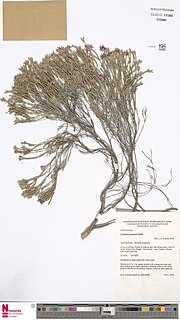
Chamelaucium, also known as waxflower, is a genus of shrubs endemic to south western Western Australia. They belong to the myrtle family Myrtaceae and have flowers similar to those of the tea-trees (Leptospermum). The most well-known species is the Geraldton wax, Chamelaucium uncinatum, which is cultivated widely for its large attractive flowers.

Allocasuarina decaisneana or desert oak is a medium-sized, slow-growing tree found in the dry desert regions of the Northern Territory, South Australia and Western Australia. The Anangu peoples know the tree as kurkara.

Hardenbergia comptoniana is a species of flowering plant in the pea family, Fabaceae, native to Western Australia. A twining vine, it produces purple flowers in the Southern Hemisphere spring. It is found on sand dunes and sand plains, and in open forest, on sand- or clay-based soils. It is readily cultivated in the garden, where it does best in a part-shaded position.
Synaphea polymorpha, commonly known as Albany synaphea, is a species of small shrub in the flowering plant family Proteaceae. It is endemic to Western Australia. The Noongar peoples know the plant as bindak.

Calytrix flavescens, commonly known as summer starflower, is a species of plant in the myrtle family Myrtaceae that is endemic to Western Australia.

Calytrix nematoclada is a species of plant in the myrtle family Myrtaceae that is endemic to Western Australia.
Chamaelaucium virgatum is a member of the family Myrtaceae endemic to Western Australia.

Micromyrtus triptycha is a plant species of the family Myrtaceae endemic to Western Australia.
Pericalymma crassipes is a plant species of the family Myrtaceae endemic to Western Australia.
Conospermum cinereum is a shrub endemic to Western Australia.
Conospermum coerulescens is a shrub endemic to Western Australia.
Conospermum distichum is a shrub endemic to Western Australia.
Conospermum filifolium is a shrub endemic to Western Australia.
Conospermum flexuosum, commonly known as the tangled smokebush, is a shrub endemic to Western Australia.
Stirlingia anethifolia is a shrub endemic to Western Australia.
Stirlingia tenuifolia is a herb or shrub endemic to Western Australia.
Synaphea obtusata is a shrub endemic to Western Australia.
Synaphea petiolaris is a shrub endemic to Western Australia.

Lobelia tenuior, commonly known as slender lobelia, is a small herbaceous plant in the family Campanulaceae native to Western Australia.
Stackhousia scoparia is a species of plant in the family Celastraceae.








